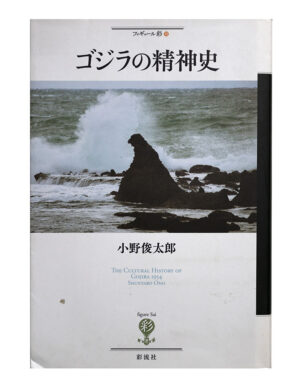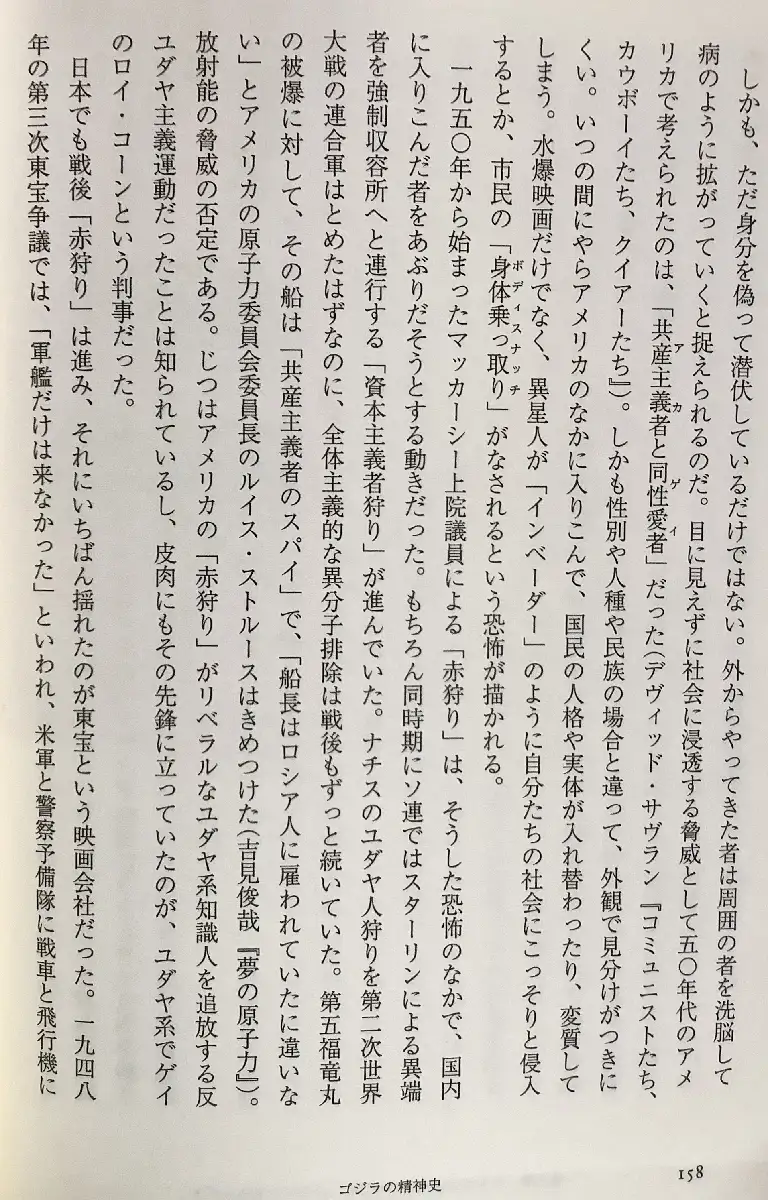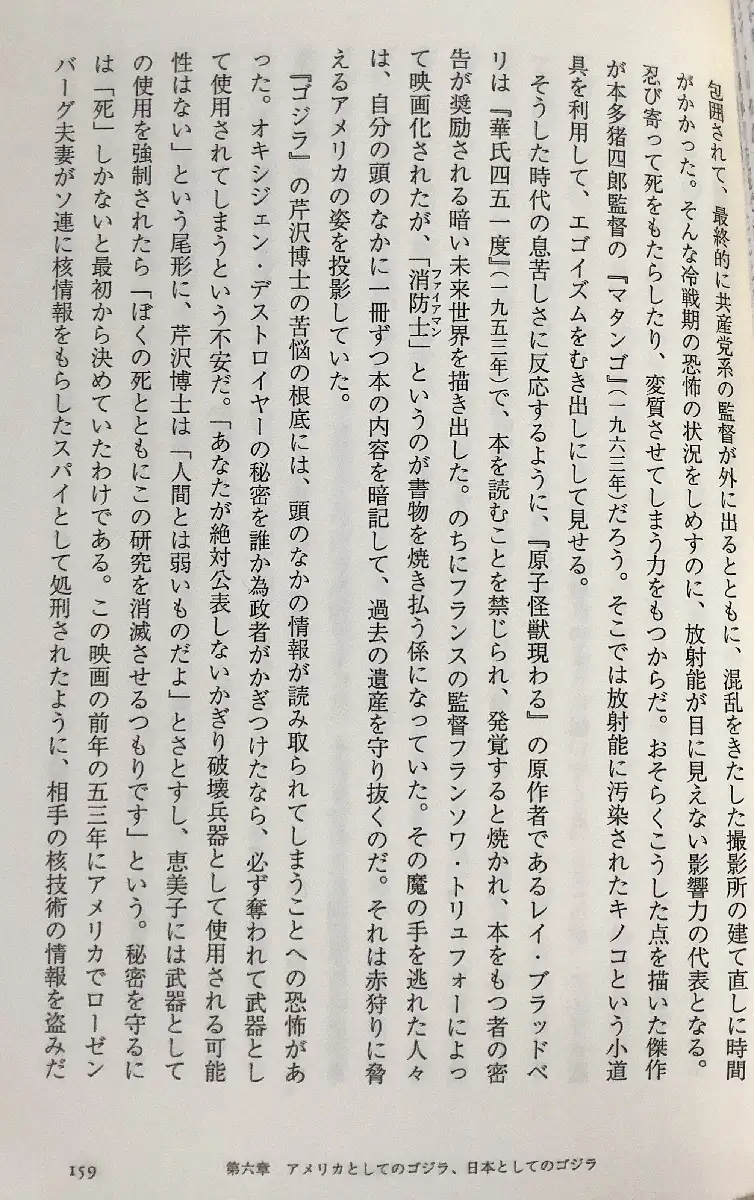8.8.2023
The Cultural History of Godzilla – Pt 59


P 157
アメリカで公開するならば、敵がアメリカ本土を襲う必要がある。H・G・ウェルズの『宇宙戦争』も火星人が襲うのはイギリスだが、それが一九五三年のハリウッド映画になるとアメリカを襲うことに変更される。自国を襲う設定の作品が多い。もちろん『キング・コング』も『原子怪獣現わる』もハリウッド版の『ゴジラ』も襲われる場所がニューヨークだから意味をもつ。
If it is to be released in the United States, the enemy needs to attack the mainland United States. In H.G. Wells’ War of the Worlds, the Martians attack England, but in the 1953 Hollywood movie, it is changed to attack America. There are many works that are set to attack one’s own country. Of course, “King Kong,” “The Beast from 20,000 Fathoms,” and the Hollywood version of “Godzilla” are all attacked in New York, so it makes sense.
こうした巨大怪物もののパニック映画では、自分たちの土地や国民が襲われなくては観客は心を揺さぶられない。あくまでも映画の定式だから、「なぜ怪獣は日本ばかりを襲うのか」という問いはそれほど重要ではないのだ。ナショナルな意識を高めるには、侵略小説や映画の系譜に基づいて、自分たちの領土が侵され、住居が破壊され、とりわけ「女子供」が蹂躙されるようすが描かれる必要がある。日米架空戦記もそうした扇動をするわけだし、第一章で述べたように「叙事詩」とは本来そういう機能をもつのである。観客にとっても制作者にとっても、そのいちばん身近な例が太平洋戦争だった。
These monstrous panic movies don’t move audiences unless their lands and people are attacked. It’s just a movie formula, so the question “Why do monsters only attack Japan?” is not so important. In order to raise national consciousness, it is necessary to draw on the genealogy of aggression novels and movies to depict the invasion of their territories, the destruction of their homes, and above all the devastation of “women and children.” The Japan-U.S. Fictitious War chronicles also instigate this kind of agitation, and as I mentioned in Chapter 1, “epic poetry” originally has such a function. The Pacific War was the most familiar example for both the audience and the filmmakers.
放射能という比喩
Metaphor of radioactivity
ただし、ゴジラがもちこんできた水爆問題は、こうした太平洋戦争の記憶を超えていて、冷戦体制に日本が組みこまれていることを告げている。ここが新しい点となる。冷戦時には見えないまま浸透してくる外部の力への恐怖が存在した。わかりやすいのは、ジェームズ・ボンドのようなスパイ物に出てくる、変装して侵入する者である。こっそりと敵地に入りこんで害をなす破壊工作者である。もちろん戦時体制であれば、どのような形であれ敵国のスパイの摘発が問題となる。
However, the hydrogen bomb problem brought by Godzilla goes beyond the memories of the Pacific War and tells us that Japan is being incorporated into the Cold War system. This is the new point. During the Cold War, there was fear of external powers that penetrated unseen. An obvious example would be an intruder in disguise in a spy story like James Bond. They are saboteurs who sneak into enemy territory and cause harm. Of course, in a wartime regime, the exposure of enemy spies would be a problem in any form.

P 158
しかも、ただ身分を偽って潜伏しているだけではない。外からやってきた者は周囲の者を洗脳して病のように拡がっていくと捉えられるのだ。目に見えずに社会に浸透する脅威として五〇年代のアメリカで考えられたのは、「共産主義者と同性愛者」だった(デヴィッド・サヴラン『コミュニストたち、カウボーイたち、クイアーたち』)。しかも性別や人種や民族の場合と違って、外観で見分けがつきにくい。いつの間にやらアメリカのなかに入りこんで、国民の人格や実体が入れ替わったり、変質してしまう。水爆映画だけでなく、異星人が「インベーダー」のように自分たちの社会にこっそりと侵入するとか、市民の「身体乗っ取り」がなされるという恐怖が描かれる。
Moreover, it is not just hiding under false identities. Those who come from outside are perceived as brainwashing the people around them and spreading like a disease. In America in the 1950s, “communists and homosexuals” (David Savran, “The Communists, the Cowboys, the Queers”) were considered as threats that permeated society invisibly. Moreover, unlike the case of gender, race, and ethnicity, it is difficult to distinguish them by appearance. Before anyone knew it, it had entered America, and the personality and substance of the people were replaced and transformed. In addition to hydrogen bomb movies, the fear of aliens secretly invading our society like “Invaders” and “body takeover” of citizens is depicted.
一九五〇年から始まったマッカーシー上院議員による「赤狩り」は、そうした恐怖のなかで、国内に入りこんだ者をあぶりだそうとする動きだった。もちろん同時期にソ連ではスターリンによる異端者を強制収容所へと連行する「資本主義者狩り」が進んでいた。ナチスのユダヤ人狩りを第二次世界大戦の連合軍はとめたはずなのに、全体主義的な異分子排除は戦後もずっと続いていた。第五福竜丸の被爆に対して、その船は「共産主義者のスパイ」で、「船長はロシア人に雇われていたに違いな「い」とアメリカの原子力委員会委員長のルイス・ストルースはきめつけた(吉見俊哉『夢の原子力』)。放射能の脅威の否定である。じつはアメリカの「赤狩り」がリベラルなユダヤ系知識人を追放する反ユダヤ主義運動だったことは知られているし、皮肉にもその先鋒に立っていたのが、ユダヤ系でゲイのロイ・コーンという判事だった。
Senator McCarthy’s “red scare,” which began in 1950, was a movement to expose those who entered the country amidst such fear. Of course, during the same period in the Soviet Union, Stalin’s “capitalist hunt” was underway, taking heretics to concentration camps. Although the Allied Forces of World War II should have stopped the Nazi hunt of Jews, the totalitarian expulsion of dissenters continued long after the war. Regarding the bombing of the Daigo Fukuryu Maru [Lucky Dragon No 5], the ship was a “communist spy” and “the captain must have been hired by the Russians,” said Louis Strauss, chairman of the U.S. Atomic Energy Commission. Kimetsuketa (Shunya Yoshimi’s “Dream Nuclear Power”). It is a denial of the threat of radioactivity. In fact, it is known that America’s “Red Scare” was an anti-Semitic movement to expel liberal Jewish intellectuals, and ironically it was spearheaded by Jewish gay Roy Cohn. was the judge.
日本でも戦後「赤狩り」は進み、それにいちばん揺れたのが東宝という映画会社だった。一九四八年の第三次東宝争議では、「軍艦だけは来なかった」といわれ、米軍と警察予備隊に戦車と飛行機に包囲されて、最終的に共産党系の監督が外に出るとともに、混乱をきたした撮影所の建て直しに時間がかかった。
In Japan, too, the “red hunt” progressed after the war, and the movie company Toho was the most shaken by it. In the 3rd Toho Dispute in 1948, it was said that “only warships did not come,” and the U.S. Army and the National Police Reserve were surrounded by tanks and planes. At the same time, it took time to rebuild the studio, which had caused chaos.

P 159
そんな冷戦期の恐怖の状況をしめすのに、放射能が目に見えない影響力の代表となる。忍び寄って死をもたらしたり、変質させてしまう力をもつからだ。おそらくこうした点を描いた傑作が本多猪四郎監督の『マタンゴ』(一九六三年)だろう。そこでは放射能に汚染されたキノコという小道具を利用して、エゴイズムをむき出しにして見せる。
Radioactivity represents an invisible force that shows the horrors of the Cold War era. Because it has the power to creep up and bring death or change. Perhaps the masterpiece depicting this point is “Matango” (1963) directed by Ishiro Honda. There, he makes use of radioactive mushrooms as props to expose his egoism.
そうした時代の息苦しさに反応するように、『原子怪獣現わる』の原作者であるレイ・ブラッドベリは『華氏四五一度』(一九五三年)で、本を読むことを禁じられ、発覚すると焼かれ、本をもつ者の密告が奨励される暗い未来世界を描き出した。のちにフランスの監督フランソワ・トリュフォーによっファイアマンて映画化されたが、「消防士」というのが書物を焼き払う係になっていた。その魔の手を逃れた人々は、自分の頭のなかに一冊ずつ本の内容を暗記して、過去の遺産を守り抜くのだ。それは赤狩りに脅えるアメリカの姿を投影していた。
As if reacting to the suffocation of such times, Ray Bradbury, the original author of The Beast from 20,000 Fathoms, writes Fahrenheit 451 (1953) about being forbidden to read books. Burned when discovered, portraying a dark future world in which those who own the book are encouraged to inform. It was later made into a movie by French director François Truffaut, with a “firefighter” in charge of burning down books. Those who have escaped the clutches of the devil memorize the contents of the books one by one in their heads to protect the legacy of the past. It projected the figure of America threatened by the Red Scare.
『ゴジラ』の芹沢博士の苦悩の根底には、頭のなかの情報が読み取られてしまうことへの恐怖があった。オキシジェン・デストロイヤーの秘密を誰か為政者がかぎつけたなら、必ず奪われて武器とし使用されてしまうという不安だ。「あなたが絶対公表しないかぎり破壊兵器として使用される可能「性はない」という尾形に、芹沢博士は「人間とは弱いものだよ」とさとすし、恵美子には武器としての使用を強制されたら「ぼくの死とともにこの研究を消滅させるつもりです」という。秘密を守るには「死」しかないと最初から決めていたわけである。この映画の前年の五三年にアメリカでローゼンバーグ夫妻がソ連に核情報をもらしたスパイとして処刑されたように、相手の核技術の情報を盗みだすことこそが冷戦期のスパイ戦の課題だった。だから、芹沢博士の苦悩は理由のないものではなかった。
At the root of Dr. Serizawa’s anguish in “Godzilla” was the fear that the information in his head would be read. The fear is that if any ruler finds out the secret of the Oxygen Destroyer, it will be stolen and used as a weapon. “There is no possibility that it will be used as a weapon of destruction unless you absolutely disclose it,” Dr. Serizawa said, “Human beings are weak.” “I intend to annihilate this research with my death,” he said. From the beginning, it was decided that death was the only way to keep a secret. Just as the Rosenbergs were executed in the United States in 1953, the year before the film, as spies for leaking nuclear information to the Soviet Union, stealing information on the other party’s nuclear technology was the task of spy warfare during the Cold War. Therefore, Dr. Serizawa’s anguish was not without reason.